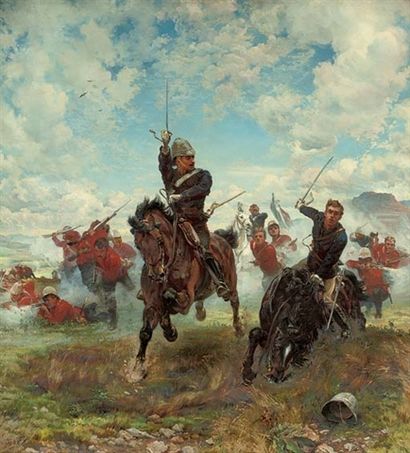Floreat Etona! facts for kids
Quick facts for kids Floreat Etona! |
|
|---|---|
 |
|
| Artist | Elizabeth Thompson, Lady Butler |
| Year | 1882 |
| Medium | Oil-on-canvas |
| Subject | Two soldiers during the battle of Battle of Laing's Nek, 28 January 1881 |
| Dimensions | 84.4 cm × 78.1 cm (33.2 in × 30.7 in) |
| Owner | Private collection |
Floreat Etona! is a famous painting from 1882 by a talented artist named Elizabeth Thompson, also known as Lady Butler. The painting's title, "Floreat Etona!", is a Latin phrase that means "May Eton flourish!". It's the motto of a famous school called Eton College. This artwork tells the story of a brave moment during a war called the First Boer War in 1881. Today, the painting is part of a private collection.
Contents
The Story Behind "Floreat Etona!"
This painting shows a dramatic event from the First Boer War. This war happened in South Africa between the British Army and the Boers (Dutch settlers). The British were trying to take control of a mountain pass called Battle of Laing's Nek.
A Brave Soldier's Last Stand
The painting focuses on Lieutenant Robert Elwes of the Grenadier Guards. He was a British soldier who fought in the Battle of Laing's Nek on January 28, 1881. The British army was trying to push through the Drakensberg Mountains.
Lieutenant Elwes joined a very risky attack. He charged up a hill on horseback, even though the Boer defenders were very strong. He was trying to encourage another soldier, Monck, who had also gone to Eton College.
"Floreat Etona!" in Battle
Elwes reportedly shouted, "Come along Monck! Floreat Etona! We must be in the front rank!" Right after saying this, he was shot and sadly died. He was one of 83 British soldiers who died that day. Monck survived the battle.
What the Painting Shows
The painting shows two British officers on horses. They are wearing blue jackets and have their swords ready. They are leading red-coated soldiers forward. The horse on the right looks like it's stumbling. The officer on the left, who is Elwes, is shouting to encourage his men.
In the background, you can see a special flag called a Queen's Colour. This battle was the last time a British army group carried its flags into a fight. You can also see the flat-topped Majuba mountain in the distance.
About the Painting's Reception
The painting is about 84.4 centimeters tall and 78.1 centimeters wide. It was shown at a big art show called the Royal Academy Summer Exhibition in 1882.
Lady Butler's paintings were usually very popular. However, this one was not a big success with art critics. Some people thought it was too emotional or sentimental. Perhaps it was because the painting showed a small, unsuccessful moment in a war that wasn't very well-known.
The painting was sold in London in June 2007 for £50,400.

